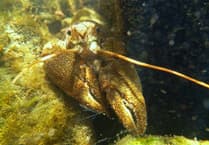Violet coloured traps are better at controlling flies than traditional blue and black ones, according to new research.
Dr Roger Santer from Aberystwyth University has worked with Kenyan academics to improve insecticide-coated targets which are used to control disease-carrying flies in sub-Saharan Africa.
By modelling fly vision, Dr Santer determined the attractive properties of colour from a fly's-eye-view, enabling him to create a colour that they would be more strongly attracted to.
Initially focusing on tsetse flies, whose bites transmit parasites that can cause ‘Sleeping Sickness’ in humans and ‘nagana’ disease in cattle, the research team created a violet polyester fabric that they confirmed to be more attractive than traditionally-used blue or black fabrics.
The latest research, published in the Journal of Economic Entomology, studied two further species of flies which transmit disease to humans and animals - stable flies and house flies – and demonstrated that violet targets also outperform traditional blue and black targets in attracting these species.
Dr Roger Santer from the Department of Life Sciences at Aberystwyth University said: “Whilst tsetse flies affect the health and welfare of humans and livestock in sub-Saharan Africa, stable flies and house flies are a global problem.”
“Our new discovery that violet targets can control several significant pests at once highlights the importance of biological insight in practical pest control, and opens the door to cost-effective, general purpose fly control tools that can improve the health and productivity of livestock, and reduce disease transmission worldwide.”
The study involved field trials in Kenya, where researchers compared fly catches at targets made from violet polyester against those at standard blue and black fabrics.
Dr Mike Okal, a scientist at the International Centre of Insect Physiology and Ecology at the time of the work, said: “We were honoured to contribute our expertise in conducting trials in Kenya. This collaborative effort with Dr Santer and the Aberystwyth University has culminated in a promising tool for mitigating the impact of insects that pose significant threats to veterinary and public health.”
The study was funded by the HEFCW Global Challenges Research Fund distributed via the Centre for International Development Research at Aberystwyth, and the German Ministry for Economic Cooperation and Development through the Deutsche Gesellschaft für Internationale Zusammenarbeit awarded to the International Centre of Insect Physiology and Ecology, Kenya.





Comments
This article has no comments yet. Be the first to leave a comment.